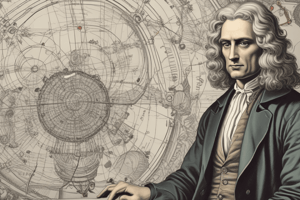Podcast
Questions and Answers
What is the main idea behind Newton's First Law of Motion?
What is the main idea behind Newton's First Law of Motion?
- The velocity of an object is directly proportional to the force applied to it.
- The force of an object is equal to the mass of the object multiplied by its acceleration.
- An object's acceleration is dependent on the force applied to it.
- An object at rest remains at rest, and an object in motion remains in motion unless acted on by an unbalanced force. (correct)
What is the significance of Newton's Laws of Motion?
What is the significance of Newton's Laws of Motion?
- They are only used to describe the motion of objects on Earth.
- They provide a universal understanding of motion, applicable to all objects. (correct)
- They are limited to the field of astronomy.
- They only apply to the motion of heavenly bodies.
Who is credited with first suggesting the heliocentric view of the universe?
Who is credited with first suggesting the heliocentric view of the universe?
- Newton
- Johannes Kepler
- Copernicus (correct)
- Galileo
What is the limitation of refracting telescopes that Newton recognized?
What is the limitation of refracting telescopes that Newton recognized?
What is the significance of Newton's discovery about the nature of light?
What is the significance of Newton's discovery about the nature of light?
What is the difference between refracting telescopes and reflecting telescopes?
What is the difference between refracting telescopes and reflecting telescopes?
What is the result of Newton's work on the nature of light?
What is the result of Newton's work on the nature of light?
What is the significance of Newton's work on Kepler's laws of planetary motion?
What is the significance of Newton's work on Kepler's laws of planetary motion?
Who was the first scientist to use a telescope to observe the motion of Jupiter's moons?
Who was the first scientist to use a telescope to observe the motion of Jupiter's moons?
What was the result of Newton's work on improving the refracting telescope?
What was the result of Newton's work on improving the refracting telescope?
Flashcards are hidden until you start studying
Study Notes
Who was Isaac Newton?
- Born on January 4, 1643, to a farmer who had died several months before
- Was placed in the care of his maternal grandmother when his widowed mother remarried
- At the age of nine, he returned to his mother's custody and was allowed to pursue academics
The Scientific Revolution
- Took place across Europe throughout the 16th-17th centuries
- Built on the ideals of the Renaissance to encourage individual discovery and critical thinking
- Focused on questions of "how" the world and the universe work, in contrast to the spiritual "why"
- Led to the development of the scientific method and the formation of prominent academic societies
Isaac Newton's Contributions
- Became recognized as one of the most notable thinkers of the Scientific Revolution
- Formulated the Three Laws of Motion and the Law of Universal Gravitation
- Invented the reflecting telescope as a response to the limitations of the refracting telescope
- Published "Mathematical Principles of Natural Philosophy" (Philosophiae Naturalis Principia Mathematica) in 1687
The Three Laws of Motion
- First Law: An object at rest remains at rest, and an object in motion remains in motion unless acted on by an unbalanced force
- Second Law: The acceleration of an object depends on the mass of the object and the amount of force applied
- Third Law: Whenever one object exerts a force on another object, the second object exerts an equal and opposite force on the first
Law of Universal Gravitation
- States that any two objects in space exert a force on each other that is related to their respective masses and the distance between them
- Formula: F = G * (m1 * m2) / R^2
Heliocentric View of the Universe
- Newton applied his work on gravity and motion to Kepler's earlier work and conclusively proved the heliocentric model
- Identified gravitational force as the reason for the elliptical orbits calculated by Kepler
Telescopic Innovations
- Newton recognized the limitations of the refracting telescope and formulated revolutionary theories about the nature of light
- Discovered that white light is composed of all colors, making color an innate property of light
- Theorized that light was made up of particles, or corpuscles
- Invented the reflecting telescope, which uses concave mirrors rather than convex lenses
Studying That Suits You
Use AI to generate personalized quizzes and flashcards to suit your learning preferences.




